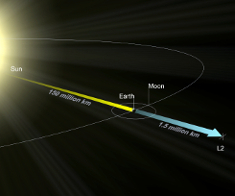Mission operations
 |
| L2 Lagrangian point. Credit: ESA |
The current baseline observing plan for PLATO's 4-year nominal science operations consists of long-duration observations of two sky fields lasting two years each. An alternative scenario is for operations split into a long-duration pointing lasting three years and a one-year step-and-stare phase with several pointings. In view of the exceptionally fast development of exoplanet science, the final observing strategy will be investigated throughout the mission development and decided two years before launch. Depending on the selected strategy, the mission will be able to cover between 10 per cent and 50 per cent of the sky during the nominal observing time.
PLATO will be launched with an Ariane 62 rocket for injection into a Lissajous orbit around the L2 Lagrangian point. To protect the instrument from solar light, it has to rotate by 90° around the line-of-sight (LoS) every 3 months.

